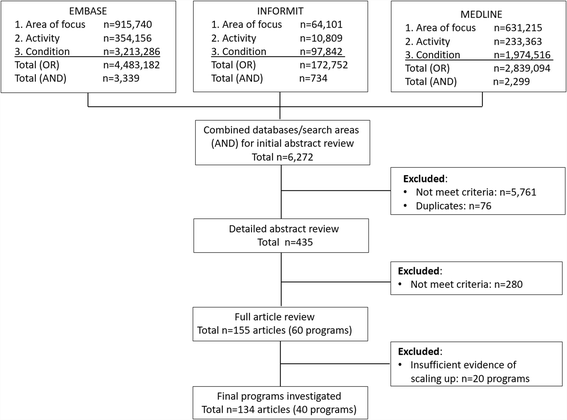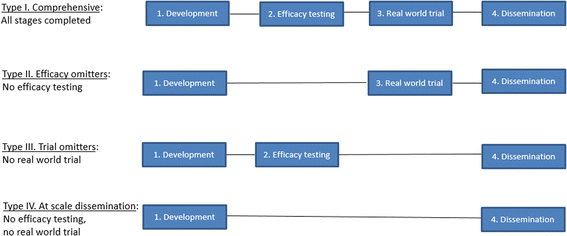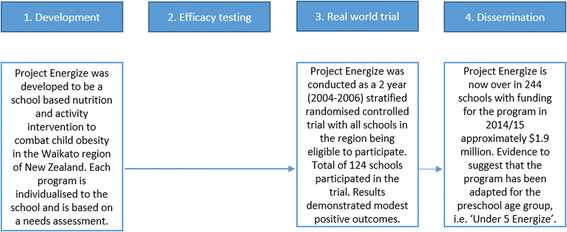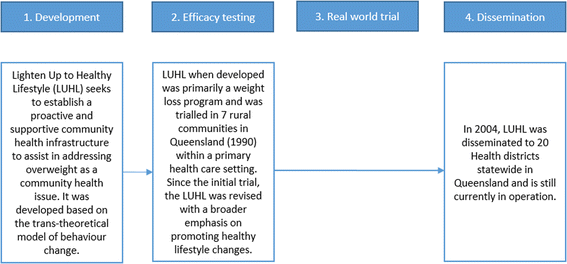Pathways for scaling up public health interventions
- PMID: 28764785
- PMCID: PMC5540381
- DOI: 10.1186/s12889-017-4572-5
Pathways for scaling up public health interventions
Erratum in
-
Erratum to: BMC Public Health, Vol. 18.BMC Public Health. 2017 Sep 22;17(1):736. doi: 10.1186/s12889-017-4709-6. BMC Public Health. 2017. PMID: 28938882 Free PMC article. No abstract available.
Abstract
Background: To achieve population-wide health improvement, public health interventions found effective in selected samples need to be 'scaled up' and implemented more widely. The pathways through which interventions are scaled up are not well characterised. The aim of this paper is to identify examples of public health interventions which have been scaled up and to develop a conceptual framework which quantifies and describes this process.
Methods: A multi-stage international literature search was undertaken to identify examples of public health interventions in high income countries that have been scaled up or implemented at scale. Initial abstract review identified articles which met all the criteria of being a: 1) public health intervention; 2) chronic disease prevention focus; 3) program delivered at a wide geographical scale (state, national or international). Interventions were reviewed and coded into a conceptual framework pathway to document their scaling up process. For each program, an in-depth review of the identified articles was undertaken along with a broad internet based search to determine the outcomes of the dissemination process. A conceptual framework of scaling up pathways was developed that involved four stages (development, efficacy testing, real world trial and dissemination) to which the 40 programs were mapped.
Results: The search identified 40 public health interventions that showed evidence of being scaled up. Four pathways were identified to capture the different scaling up trajectories taken which included: 'Type I - Comprehensive' (55%) which passed through all four stages, 'Type II - Efficacy omitters' (5%) which did not conduct efficacy testing, 'Type III - Trial omitters' (25%) which did not conduct a real world trial, and 'Type IV - At scale dissemination' (15%) which skipped both efficacy testing and a real world trial.
Conclusions: This is the first study to classify and quantify the potential pathways through which public health interventions in high income countries are scaled up to reach the broader population. Mapping these pathways not only demonstrates the different trajectories that occur in scaling up public health interventions, but also allows the variation across scaling up pathways to be classified. The policy and practice determinants leading to each pathway remain for future study, especially to identify the conditions under which efficacy and replication stages are missing.
Keywords: Program implementation; Public health interventions; Scaling up.
Conflict of interest statement
Ethics approval and consent to participate
Not applicable.
Consent for publication
Not applicable.
Competing interests
The authors declare that they have no competing interests.
Publisher’s Note
Springer Nature remains neutral with regard to jurisdictional claims in published maps and institutional affiliations.
Figures







References
-
- World Health Organization and ExpandNet. Nine steps for developing a scaling-up strategy. 2010, WHO: Geneva.
-
- Milat AJ, Newson R, Wolfenden L, Rissel C, Bauman A, Redman S. Increasing the scale and adoption of population health interventions: experiences and perspectives of policy-makers, practitioners and researchers. Health Research Policy and Systems. 2014;12:18. doi: 10.1186/1478-4505-12-18. - DOI - PMC - PubMed
Publication types
MeSH terms
LinkOut - more resources
Full Text Sources
Other Literature Sources
Medical
Miscellaneous

